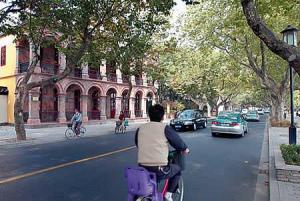1) Historical Cultural region


历史文化场所
2) the Conservation of Historic Industrial Site Culture


场所历史文化价值延续
3) historic surrounding


历史场所
1.
The new volumes must be harmony with the historic surrounding and the contemporary culture characteristic must be present in plan,which is a typical idea about the renovation of the historic build.
提出新增体量以单一、完整、纯几何化的建筑形态直接介入历史场所,通过与历史建筑的对比而融入原有环境,在尊重历史的同时展现当代的文化特征并最终成为历史建筑新生的标志已成为同类工程项目中一种有代表性的创作理念。
4) Historic places


历史性场所
5) History and Culture


历史文化
1.
Exploration of the history and culture tourist resources in Luzhou;


泸州市历史文化旅游资源开发探讨
2.
On innovative spirits as a pearl in Zhenjiang history and culture;


创新精神是镇江历史文化宝库中光芒四射的瑰宝——以“三星”、“双璧”、“二米”为例
3.
The paper bases on the conservation and renewal planning of old-city which is along the Xiangjiang River and in the west of that in Xiangtan,and discusses how to protect and keep history and culture in old-city renewal from material-lay and immaterial-lay,so that the city memory and historic contexture will go down.
结合湘潭市河西沿江旧城保护与更新项目,从物质和精神层面来探讨旧城更新中历史文化的保护和延续问题,以期保存城市记忆,延续城市历史文脉。
6) Historic culture


历史文化
1.
There is a conflict between the protection of the historic culture of Ciqikou and residents demands for the modernity in existence.
在进行重庆磁器口古街区保护和更新时,从人性化的角度上提出了双系统模式以解决矛盾,即通过修缮和清理,保存和恢复历史的街巷、院落空间及民居建筑形式,以保护完整的当地的历史文化系统;根据所在的特殊地理环境,通过修建现代城市生活环线和沿环线对住宅进行模式化加建,为古街区居民营造现代城市生活系统,建立起人和物、整体和局部、传统和现代同时考虑的双系统模式。
2.
Characteristic-city-building should strenghten on protecting historic culture and constructing basic and pubic service facilities.
构建特色城市应坚持高标准规划,避免"克隆"现象;城市规划建设应结合地形和城市性质加大历史文化名城保护力度;加强个性化基础设施和公共服务设施建设;塑造丰富的城市特色人性。
3.
At last,it pointed out that the idea of reasonable exploring urban renew has positive meaning to continue and preserve historic culture and regional characteristics.
通过对青岛市中山路现状的分析,应用更新改造理论,从功能定位、设施改善、构思特点等方面提出了更新策略,以达到延续历史,突出特色文化的效果,最后指出合理探求城市更新的思路对历史文化及地域特色的延续和传承具有积极的意义。
补充资料:北山街历史文化保护街区

北山街历史文化保护街区
在这条路上,你随时随地都有可能撞上历史,撞上文物,其间的一草一木,一楼一舍,一砖一瓦都透露着浓郁的民国文化。东起断桥口,西至曙光路的北山街全长2600米,被人们称为“没有围墙的博物馆”
位于北山街45号的这幢有着精致门楼的建筑叫“菩提精舍”,看到这个名字的朋友可能会想,它是不是与佛教有什么关联,事实上这两者之间可以说毫无联系。菩提精舍建于1926年,由于甘仁等24位商界名流联合建造的,他们之中大部分是当时在上海创业的浙江人
沿着栅栏往前走,来到的是新新饭店的第三幢主楼:秋水山庄。大家觉得它肯定与女子有关,这“秋水”两字确实是这幢山庄女主人沈秋水的名字
说明:补充资料仅用于学习参考,请勿用于其它任何用途。